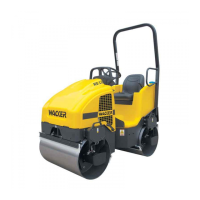Vibration System and Steering RD 12 / RD 12A
wc_tx000668gb.fm 56
6 Vibration System and Steering
Both the vibration and steering system share the same open loop, series circuit, driven by a
fixed displacement, gear-type pump (exciter pump). The system includes separate relief
valves for vibration and steering, an exciter control valve exciter motor, steering valve, and
steering cylinder.
Vibration
circuit
The exciter pump pulls oil from the tank through the suction filter and sends it to the exciter
manifold block. The vibration circuit is controlled by the exciter solenoid valve. This valve is
electrically operated by an ON/OFF switch located on the end of the forward/reverse con-
trol lever. Supply oil from the exciter pump is directed to the exciter control valve. When the
ON/OFF switch is in the OFF position, the exciter control valve is open, allowing oil to pass
downstream to the steering valve without driving the exciter motor. When the ON/OFF
switch is in the ON position, the exciter control valve closes and directs oil to the exciter
motor which drives the eccentric weights in the front drum. Return oil from the exciter motor
flows to the steering valve. A relief valve connected across the exciter control valve limits
pressure to 200 bar (2900 psi).
Steering
circuit
Steering is controlled by a steering valve and cylinder. The steering wheel is spline-
mounted directly to the steering valve. The steering valve reacts to the motion of the steer-
ing wheel to direct oil to and from the steering cylinder. Oil returning from the vibration cir-
cuit is directed to the steering valve. If steering is inactive, oil passes through the steering
valve and back to the return-line filter manifold. When the steering wheel is turned, the
steering valve closes and directs oil to the appropriate steering line to extend or retract the
cylinder.
A relief valve is connected across the steering valve and is set at 45–51 bar (650–725 psi).
Relief valves are also connected to each end of the steering cylinder. Each of these relief
valves is also set at 45–51 bar (650–725 psi).
The oil returning from the vibration and steering functions is directed back to the tank
through a return-line filter. A filter bypass relief valve, set at 1.7 bar (25 psi), protects the
return-line filter by routing oil past the filter if the filter is clogged.
Troubleshoot-
ing sequence
When troubleshooting:
For systems that vibrate poorly, see section Troubleshooting a System that Vibrates
Poorly.
For complete vibration system failure, see sections Checking the Vibration Solenoid
Valve and Checking the Vibration Switch.

